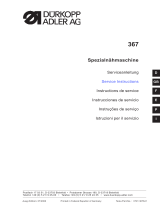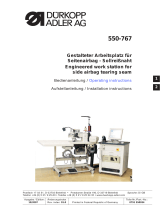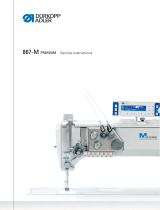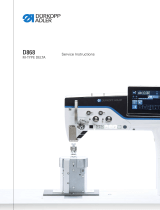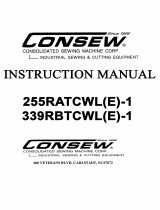
767
Spezialnähmaschine
Serviceanleitung
Service Instructions
Postfach 17 03 51, D-33703 Bielefeld • Potsdamer Straße 190, D-33719 Bielefeld
Telefon +49 (0) 521 / 9 25-00 • Telefax +49 ( 0) 521 / 9 25 24 35 • www.duerkopp-adler.com
Ausgabe / Edition: Änderungsindex Teile-Nr./Part.-No.:
10/2008 Rev. index: 02.0 Printed in Federal Republic of Germany 0791 767651
D
GB

Alle Rechte vorbehalten.
Eigentum der Dürkopp Adler AG und urheberrechtlich geschützt. Jede, auch auszugsweise Wiederverwendung
dieser Inhalte ist ohne vorheriges schriftliches Einverständnis der Dürkopp Adler AG verboten.
All rights reserved.
Property of Dürkopp Adler AG and copyrighted. Reproduction or publication of the content in any manner, even
in extracts, without prior written permission of Dürkopp Adler AG, is prohibited.
Copyright ©
Dürkopp Adler AG - 2008.

General safety instructions
The non-observance of the following safety instructions can cause
bodily injuries or damages to the machine.
1. The machine must only be commissioned in full knowledge of the
instruction book and operated by persons with appropriate training.
2. Before putting into service also read the safety rules and
instructions of the motor supplier.
3. The machine must be used only for the purpose intended. Use of
the machine without the safety devices is not permitted. Observe all
the relevant safety regulations.
4. When gauge parts are exchanged (e.g. needle, presser foot, needle
plate, feed dog and bobbin) when threading, when the workplace is
left, and during service work, the machine must be disconnected
from the mains by switching off the master switch or disconnecting
the mains plug.
5. Daily servicing work must be carried out only by appropriately
trained persons.
6. Repairs, conversion and special maintenance work must only be
carried out by technicians or persons with appropriate training.
7. For service or repair work on pneumatic systems, disconnect the
machine from the compressed air supply system (max. 7-10 bar).
Before disconnecting, reduce the pressure of the maintenance unit.
Exceptions to this are only adjustments and functions checks made
by appropriately trained technicians.
8. Work on the electrical equipment must be carried out only by
electricians or appropriately trained persons.
9. Work on parts and systems under electric current is not permitted,
except as specified in regulations DIN VDE 0105.
10. Conversion or changes to the machine must be authorized by us
and made only in adherence to all safety regulations.
11. For repairs, only replacement parts approved by us must be used.
12. Commissioning of the sewing head is prohibited until such time as
the entire sewing unit is found to comply with EC directives.
13. The line cord should be equipped with a country-specific mains
plug. This work must be carried out by appropriately trained
technicians (see paragraph 8).
It is absolutely necessary to respect the safety
instructions marked by these signs.
Danger of bodily injuries !
Please note also the general safety instructions.


Index Page:
Service Instructions Class 767
1. General notes
1.1 Gauge kit................................................... 3
2. Position of the low er toothed belt w heel .............................. 4
3. Zero position, feed w ith equipment
3.1 Zero position adjustment (position of the stitch regulator link) ................... 5
3.2 Bottomfeedadjustment.......................................... 6
3.2.1 Position of the feed-dog in the throat plate cutout .......................... 6
3.2.2 Height of the feed-dog ........................................... 7
3.2.3 Lifting motion of the feed-dog ...................................... 8
3.2.4 Feeding motion of the feed-dog ..................................... 9
3.2.5 Synchronous run of needle feed and bottom feed .......................... 10
3.3 Needle bar wing .............................................. 13
3.3.1 Lateral position of the needle bar wing ................................. 13
3.3.2 Position of the needle bar wing in feed direction ........................... 14
4. Hook settings
4.1 Looping stroke ............................................... 15
4.2 Needle bar height ............................................. 16
4.3 Distance between hook and needle ................................... 17
4.4 Hookprotection............................................... 18
4.5 Clearanceintheclawclutch....................................... 19
5. Stitch regulator settings
5.1 Limitation of maximum stitch length ................................... 20
5. 2 Limitation of the max. stitch length for machines equipped with 2nd stitch length as standard . . 21
5 .3 Basic settings of stitch adjustments for machines equipped with 2nd stitch length as standard . . . 21
5. 4 Operating the stitch adjustments for machines equipped with 2nd stitch length as s tandard . . . 23
6. Bobbin case opening settings
6.1 Bobbin case opening............................................ 24
6.1.1 Size of the finger run............................................ 24
6.1.2 Liftingcourse................................................ 25
6.1.3 Timing of the bobbin case opening ................................... 25
7. Upper feed settings
7.1 Altering the upper feed .......................................... 26
7.1.1 Lateral position of the lever for transmitting the setting wheel motion............... 26
7.1.2 Setting range of the s ewing foot stroke adjustment .......................... 27
7.1.3 Position of the lever for transmitting the setting wheel motion ................... 28
7.2 Feeding foot and presser foot ...................................... 29
7.2.1 Feeding foot and presser foot stroke .................................. 29
7.2.2 Lifting motion of the feeding foot..................................... 30
7.3 Potentiometer for automatic speed limitation ............................. 31
8. Sew ing foot height and sew ing f oot lift settings
8.1 Electropneumatic sewing foot lift .................................... 34
8.2 Sewingfootlocking ............................................ 37
8.3 LiftLimitation................................................ 38
9. Thread tension lift
9.1 Thread tension opening .......................................... 39
9.2 Threadtensionlift ............................................. 40
10. Safety clutch
10.1 Engage disengaged safety clutch .................................... 41
10.2 Adjusttransmittabletorque........................................ 42
GB

Index Page:
11. B obbin w inder ............................................... 43
12. Lubrication
12.1 General hints concerning the oil lubrication .............................. 46
12.2 Hooklubrication .............................................. 47
12.3 Change oil ................................................. 48
12.4 Oillevelinthefluidreservoir ...................................... 49
12.5 Mounting of the head cover ........................................ 51
13. Thread trimmer (Class 767-FA-...)
13.1 Function sequence ............................................. 52
13.2 Thread pulling knife ............................................ 53
13.3 Counter knife and underthread clamp .................................. 54
13.4 Guide curve, slewing range of the thread pulling knife and roller lever .............. 55
14. Short thread trimmer (KFA-373)
14.1 Parametersettings............................................. 56
14.2 Mechanical setting of the short thread trimmer ............................ 56
14.3 Short thread trimmer for oversized hook ................................ 59
14.4 Adjustthethreadcuttingstitchbeforethreadcutting......................... 62
14.5 Thread clamp (Thread feeding device) ................................. 63
14.6 Errors,causeandremedy......................................... 63
15. Short thread trimmer (KFA-573)
15.1 Parametersettings............................................. 64
15.2 Mechanical adjustment of the short thread trimmer ......................... 64
15.3 Settingthethreadtrimmingstitchfortheshortthreadtrimmer................... 69
15.4 Thread clamp (thread pulling device) .................................. 70
15.5 Possiblefaults,causeandremedyfortheshortthreadtrimmer.................. 70
16. Synchronizer ................................................ 71
17. Controls and Control Panel Efka
17.1 Positioning.................................................. 72
17.2 Setting the parameters values with the V810 control panel ..................... 75
17.3 Masterreset................................................. 77
18. Automatic speed adaptation
18.1 General.................................................... 78
18.2 Setting the “Speedomat” function .................................... 79
19. Optional Equipment
19.1 RAP 13-2 Electro-pneumatic seam bartacking ............................ 81
19.2 RAP 13-4 Electro-pneumatic seam bartacking ............................ 81
19.3 NP 13-4 Electro-pneumatic needle return device ........................... 82
19.4 HP 13-7 Electro-pneumatic quick stroke adjustment (Speedomat) ................ 83
19.5 RFW13-3Remainingthreadmonitor ................................. 84
19.6 RFW13-8Remainingthreadmonitor.................................. 84
19.7 RFW13-9Remainingthreadmonitor.................................. 84
19.8 RFW13-6Remainingthreadmonitor.................................. 84
19.9 Connecting the c ontrols and the s olenoid valve for the remaining thread monitor ....... 85
19.10 STLS 13-2 2nd stitch length ....................................... 86
19.11 VAVerticalCutter.............................................. 88
19.12 AE Edge cutter and binder ........................................ 91
19.13 Seamcenterguide ............................................ 93
19.14 FS 13-1 Additional tension ........................................ 93
19.15 NK 13-1 Needle cooling .......................................... 93
19.16 LR13-4Lightbarrier ........................................... 93
19.17 SP470Rollerfeeddevice ........................................ 94
19.18 WTA13-2Automaticlowering ...................................... 94
19.19 SkipStitchDetectionFSE13-1/2 .................................... 94
20. Maintenance ................................................ 95

1. General notes
ATTENTION !
The operations described in the service instructions must only be
executed by qualified staff or correspondingly instructed persons
respectively!
Caution: Danger of injury !
In case of repair, alteration or maintenance work switch off main
switch and disconnect the machine from the pneumatic supply
system.
Carry out adjusting operations and functional tests of the running
machine only under observation of all s afety measures and with
utmost caution.
The instruction manual on hand describes the adjustment of the sewing
machine in an appropriate sequence.
Please observe in this connection that various setting positions are
interdependent. Therefore it is absolutely necessary to do the
adjustment following the described order.
For all setting operations of parts involved in the stitch formation a new
needle without any damage has to be inserted.
1.1 Gauge kit
The setting gauges mentioned below allow a precise setting and testing
of the sewing machine.
Pos. Setting gauge Order No. Use
1 Gauge 0981 150003 looping stroke (2mm)
2 Adjusting block 0981 150002 looping stroke
3 Gauge 0767 250020 sewing foot stroke adj.
(lever position)
3
GB
1
2

2. Position of the lower toothed belt wheel
Caution: Danger of injury !
Switch off main switch.
Check and adjust the position of the lower toothed belt wheel
only when the sewing machine is switched off.
Standard checking
The lower toothed belt wheel 5 is axially and radially fixed on shaft 6 via
core pin 3.
The position of the lower toothed belt wheel 5 is correct if core pin 3
(first core pin in direction of rotation) can be screwed in drill-hole 7 of
the shaft.
Correction
–
Loosen core pins 1 and 3 at the slip clutch 4.
–
Twist lower toothed belt wheel 5 with slip clutch 4 on shaft 6 and/or
shift axially.
It must be possible to screw core pin 3 (first core pin in direction of
rotation) in the drill-hole 7 of shaft 6.
–
Check all settings described hereafter and correct them, if
necessary.
4
2
1
4
5
3
67
1
4
5
3
2

3. Zero position, feed with equipment
3.1 Zero position adjustment (position of the stitch regulator link)
Caution: Danger of injury !
Switch off main switch.
Check and adjust zero position of the stitch regulator only when
the sewing machine is switched off.
Standard checking
If stitch length “0” is set, feed-dog and needle must not make a feeding
motion when turning the handwheel.
–
Remove cover of oil pan 4.
–
Set stitch length to “0”.
–
Put Allen k ey in screw 1 and turn handwheel.
The adjustment is correct at the slightest possible motion of the
Allen key.
Correction
–
Loosen clamping screw 5 at block 6.
–
Put a pin in drill-hole 3 of the stitch regulator shaft.
Twist stitch regulator shaft with stitch regulator link.
–
Tighten clamping screw 5.
ATTENTION !
In case of a wrong adjustment the backward s titch lengths and the
forward stitch lengths will differ.
The core pin 2 at the oil pan fixes the stitch regulator shaft.
Neverscrewinthecorepin2uptothebottom.
If the core pin 2 is screwed in too deeply, the motion of the stitch
regulator link can be hindered.
5
GB
1
2
3
5
6
4

3.2 Bottom feed adjustment
3.2.1 Position of the feed-dog in the throat plate cutout
Caution: Danger of injury !
Switch off main switch.
Check and adjust position of the feed-dog only when the sewing
machine is switched off.
Standard checking
Lateral position:
The feed-dog 2 must be in the centre of the throat plate cutout 1.
Position in feed direction:
In case of maximum stitch length the distance between feed-dog 2 and
throat plate cutout 1 must be equal at the back (a) and at the front (b).
–
Set maximum stitch length.
Turn the button in clockwise direction as far as it will go.
–
Turn handwheel and check position of feed-dog 2.
Correction
–
Loosen screws 6 and 7.
–
Adjust feed-dog bar 8 in such a way that the above-mentioned
conditions are fulfilled.
–
Tighten screws 6 and 7 again.
–
Check whether the lifting shaft crank has lateral clearance to joint 13.
If not, the position of the lifting shaft crank 6 has to be changed
correspondingly.
–
Loosen screws 3 and 4.
–
Loosen screw 10.
–
Adjust the position of the lifter shaft 5.
–
Tighten screws 3, 4 and 10 again.
The tratcion rod 9 must lie centered on the eccentric 11 and the
shaft 5 must be axially fixed.
6
21
11
9
10
345
67813
212

3.2.2 Height of the feed-dog
Caution: Danger of injury !
Switch off main switch.
Check and adjust height of the feed-dog only when the sewing
machine is switched off.
Standard checking
Sew ing machines w ithout feed dog stroke:
The feed dog 6 should have the same height as the needle plate 7 in its
highest position.
Correction
–
Set stitch length to “0".
–
Loosen screw 5
–
Turn the s troke shaft 3.
The feed dog should have the same height as the needle plate.
–
Tighten screw 5 again.
Standard checking
Sew ing machines w ith feed dog stroke:
In its highest position the feed dog should extend 0.5 mm out of the
needle plate 7.
Correction
–
Set stitch length to “0".
–
Loosen screw 4.
–
Turn the s troke shaft 3.
In its highest position the feed dog 6 should extend 0.5 mm out of
the needle plate 7.
–
Tighten screw 4 again.
The tie rod 2 must lie centered on the eccentric 1.
–
Check if the setting blocks 8 and 9 can still move freely.
If not, then the two setting blocks 8 and 9 must be turned on the
stroke shaft.
The setting blocks may not be axially displaced w hen doing this.
7
GB
3241
53
67
98

3.2.3 Lifting motion of the feed-dog
Caution: Danger of injury !
Switch off main switch.
Check and adjust lifting motion of the feed-dog only when sewing
machine is switched off.
Standard checking
At needle position “down” the feed-dog must have reached its highest
position.
If the needle moving downwards and the feed-dog moving upwards
reach the throat plate level simultaneously, the adjustment is correct.
–
Set stitch length to “0".
Turn button c ounter-clockwise as far as it will go.
–
Move needle to position “down” by handwheel and check position of
the feed-dog.
Correction
–
Loosen two screws 5.
–
Twist eccentric 3.
The adjustment is correct if the above-mentioned conditions are
fulfilled.
–
For axial fixation press shaft 4 to the right and push eccentric 3 to
the left against the pump.
The lugs 2 of pump ring 1 must be in the corresponding grooves of
the eccentric 3.
–
Tighten two screws 5 again.
8
1
2
3
4
5

3.2.4 Feeding motion of the feed-dog
Caution: Danger of injury !
Switch off main switch.
Check and adjust feeding motion of the feed-dog only when sewing
machine is switched off.
Standard checking
When actuating the stitch regulator shaft with the max. stitch
length, the needle should not move when reaching its bottom
dead center or 0.7 mm before.
–
Set maximum stitch length.
–
Turn handwheel until the needle reaches its bottom dead center or
is 0.7 mm above its bottom dead center.
–
Turn the stitch regulator shaft and observe the needle.
Correction
–
Loosen two screws 1.
–
Set eccentric 2.
–
The needle must not move 0.5 mm after the bottom dead centre.
Position eccentric 2 axially.
The tie rod 3 should be central to the running surface of the
eccentric.
–
Tighten two screws 1 again.
Hint
In order to obtain a constant loop stroke for forward and backward
sewing, the needle bar should not move any longer for the first 2 mm
loop stroke setting.
However the needle would still continue oscillating with the needle
stitching the material, while the cloth preser foot still holds the material.
This can lead to needle breakage.
9
GB
1
2
3

3.2.5 Synchronous run of needle feed and bottom feed
The motion of the feeding shaft 3 is transmitted via block 2 and tie rod 5
to lever 6 and from there via tie rod 3 and lever 2 to needle bar wing 1.
Caution: Danger of injury !
Switch off main switch.
Check and adjust position of block 6 only when sewing machine is
switched off.
Standard checking
During the feed the needle must not move in the needle hole. At stitch
length “0" block 2 must be in perpendicular position.
–
Set stitch length “0”.
–
Check position of block 2.
Block 2 must be in parallel position to the cast edge of the casing.
–
Lock sewing feet in lifted position with lifting lever 8.
–
Set maximum stitch length.
–
Turn handwheel and check the synchronous feeding motion of
feed-dog and needle bar.
The adjustment is correct if the position of the needle in the needle
hole of the feed-dog does not change.
Correction
–
Loosen clamping screws 4 and 7.
–
Twist block 2 on feeding shaft 3.
–
Tighten clamping screws 4 and 7.
ATTENTION !
After twisting of block 2 it has to be checked that the needle
bar wing 1 is positioned in feed direction. Correct, if necessary
(see chapter Position of the needle bar wing in feed direction).
10
7
1
6
5
2
3
4
8

Notes:
11
GB

12
12 3
45 6
12
7
11
8
910
13
14
15
9

3.3 Needle bar wing
Preconditions for the positioning of the needle bar
–
Position of feed-dog in the throat plate cutout is adjusted c orrectly
(see chapter 3.2.1).
–
Synchronous run of needle feed and bottom feed is adjusted
correctly (see chapter 3.2.5).
3.3.1 Lateral position of the needle bar w ing
Caution: Danger of injury !
Switch off main switch.
Check and adjust lateral position of the needle bar wing only when
sewing machine is switched off.
Standard checking
At stitch length “0" the needle must stick in the centre of the needle
hole of the feed-dog.
–
Set stitch length “0”.
–
Move needle in position “down” by handwheel.
–
Check position of the needle in the needle hole of the feed-dog.
Correction
–
Screw off arm cover.
–
Loosen clamping screws 8 at both clamping blocks 10.
–
Loosen both clamping screws 7 and core pin 11 at the needle bar
crank 12.
–
Loosen core pins 4 and 6.
–
Loosen screw 13 at lever 14.
–
Position needle bar wing 9 laterally.
The needle must stick in the centre of the needle hole of the
feed-dog.
–
If necessary, shift the shaft for the sewing foot drive axially.
Loosen clamping screws 1 and 2 at the setting rings and clamping
screw 3 at the block.
Shift the shaft axially.
Tighten clamping screws 1,2 and 3 again afterwards.
–
Tighten all screws which had been loosened.
Please observe the following:
- Needle bar wing 9 must be fixed axially.
- Both clamping blocks 10 must be in horizontal position.
- Core pin 11 must be on the surface of the crank pin.
- Lever 15 must be in perpendicular position.
- The oil wicks must be in correct position.
- The lateral clearance of the thread lever control 5 must be
adjusted as low as possible.
- The stroke heights of both sewing feet must be identical.
ATTENTION
After the lateral positioning of the needle bar wing:
–
Check distance between hook and needle and correct, if
necessary (see chapter Hook settings).
13
GB

3.3.2 Position of the needle bar w ing in f eed direction
Caution: Danger of injury !
Switch off main switch.
Check and adjust position of needle bar wing in feed direction only
when sewing machine is switched off.
Standard checking
At stitch length “0" the needle must stick in the centre of the needle
hole of the feed-dog.
–
Set stitch length to “0”.
–
Move needle in position “down” by turning the handwheel
–
Check position of the needle in the needle hole of the feed-dog.
Correction
–
Screw off arm cover.
–
Loosen clamping screw 13 at lever 14.
–
Twist needle bar wing 9 until the needle is centric above the needle
hole of the feed-dog.
–
Tighten clamping screw 13.
Replacing the oscillating crank
When replacing the oscillating crank, the following items must be
observed:
–
The wick 4 leading from the oil sump 3 to the oscillating crank 9
must be fixed between the groove 5 in the cast iron and the spiral
spring 6 of the recirculation wick.
–
The recirculation felt pad 2 must have the position to the plastic
foil 1 shown in the picture.
ATTENTION
After replacement of the oscillating crank or when the sideways
position was changed, the clearance of the hook to the needle
is to be checked and corrected, if necessary.
14
12
13
13
14
15
9
34569

4. Hook settings
4.1 Looping stroke
Caution: Danger of injury !
Switch off main switch.
Check and adjust looping stroke only when sewing machine
is switched off.
Standard checking
The looping stroke (2 mm) is the way of the needle bar from the bottom
dead centre to the point where the hook tip 11 is at the level of the middle
of the needle. The looping stroke is controlled by means of setting block 4
(Order No. 0981 150002) and gauge 3 (Order No. 0981 150003).
–
Check whether safety clutch 12 snaps in (see c hapter Safety clutch)
–
Screw off throat plate.
–
Set stitch length to “0”.
–
Move needle in position “down” by handwheel.
–
Press gauge 3 with block 4 against wing 2.
–
Tighten screw 7 and pull out gauge 3.
–
Turn handwheel in travel direction until block 4 abuts o n needle
bar wing 2 (looping stroke position).
In this position the hook tip 11 must be at the level of the middle of
the needle.
Correction
–
Loosen screws 5 at the clamping rings 6.
–
Twist hook until hook tip 11 is at the level of the middle of the needle.
–
Position shaft 8 axially.
The clearance between the clutch claws 9 and 10 must amount to
0.5 mm.
–
Position clamping rings 6 flush with the steps in driving shaft 8.
–
Tighten screws 5.
ATTENTION !
After a correction of the looping stroke the following adjustment
is to be checked and corrected, if necessary:
(see chapter 4.4 Hook protection)
15
GB
0,5 mm
1
3
4
5
6
7
8
9
10
2
11
12

4.2 Needle bar height
Caution: Danger of injury !
Switch off main switch.
Check and adjust needle bar height only when sewing machine is
switched off.
Standard checking
In looping stroke position the hook tip must be at the level of the middle
of the needle hollow groove 3.
–
Move needle in looping stroke position by handwheel.
In looping stroke position the hook tip is at the level o f the middle of
the needle.
–
Check position of the hook tip to the needle hollow groove 3.
Correction
–
Take off head cover.
–
Loosen both screws 1.
–
Adjust the height of needle bar 2 in such a w ay that the hook tip is
at the level of the middle of the needle hollow groove 3.
Attention!
Needle bar 2 must not be twisted when being shifted.
–
Tighten screws 1.
ATTENTION !
After a correction of the needle bar height:
Check position of the hook protection and correct it, if necessary.
A w rong adjustment of the needle bar height can have the following
consequences:
–
Damage to the hook tip
–
Jamming of the bobbin thread between needle and needle
protection
16
1
2
3
Page is loading ...
Page is loading ...
Page is loading ...
Page is loading ...
Page is loading ...
Page is loading ...
Page is loading ...
Page is loading ...
Page is loading ...
Page is loading ...
Page is loading ...
Page is loading ...
Page is loading ...
Page is loading ...
Page is loading ...
Page is loading ...
Page is loading ...
Page is loading ...
Page is loading ...
Page is loading ...
Page is loading ...
Page is loading ...
Page is loading ...
Page is loading ...
Page is loading ...
Page is loading ...
Page is loading ...
Page is loading ...
Page is loading ...
Page is loading ...
Page is loading ...
Page is loading ...
Page is loading ...
Page is loading ...
Page is loading ...
Page is loading ...
Page is loading ...
Page is loading ...
Page is loading ...
Page is loading ...
Page is loading ...
Page is loading ...
Page is loading ...
Page is loading ...
Page is loading ...
Page is loading ...
Page is loading ...
Page is loading ...
Page is loading ...
Page is loading ...
Page is loading ...
Page is loading ...
Page is loading ...
Page is loading ...
Page is loading ...
Page is loading ...
Page is loading ...
Page is loading ...
Page is loading ...
Page is loading ...
Page is loading ...
Page is loading ...
Page is loading ...
Page is loading ...
Page is loading ...
Page is loading ...
Page is loading ...
Page is loading ...
Page is loading ...
Page is loading ...
Page is loading ...
Page is loading ...
Page is loading ...
Page is loading ...
Page is loading ...
Page is loading ...
Page is loading ...
Page is loading ...
Page is loading ...
Page is loading ...
/

